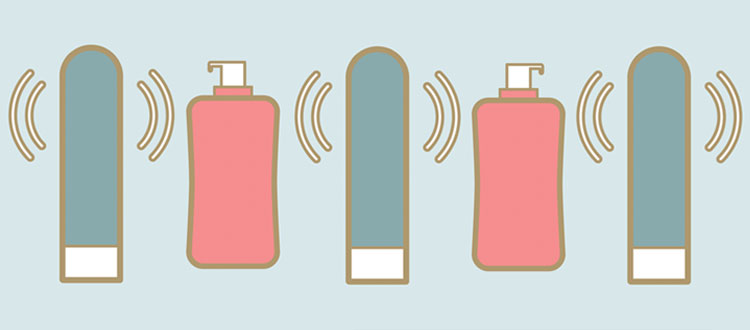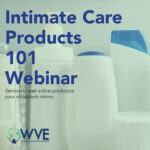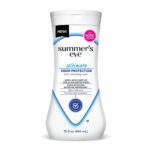Non-Toxic Vibes: Finding Safer Vibrators, Sex Toy Cleaners and Lubes
 |
| Alex Scranton Director of Science and Research |
In the mood? Great! But first, here’s some news you need to know…
1. When it Comes To Vibrators, Avoid PVC
For a while now we have been concerned about sex toys made of vinyl (PVC plastic). In addition to the many environmental hazards of vinyl, this plastic can also contain phthalates that are reproductive toxicants. We came to learn that vibration can significantly increase the rate at which phthalates leach out of PVC plastic – which made us especially concerned for the safety of vibrating sex toys made of vinyl. Were they unleashing excessive levels of phthalates directly to sensitive vaginal tissue? Yikes! So we did some research into it. And the good news is that the sex toy industry appears to have gotten the memo and fixed the problem. Not only are there a large variety of vibrating sex toys made of alternative plastics (i.e. non-vinyl plastics or silicone that don’t generally contain phthalates) but most of the vinyl toys we looked at specifically stated that they were now “phthalate-free”! Now, companies don’t always tell the truth – especially when there aren’t actually any laws requiring them to go phthalate free. So we collaborated with our colleagues at the Ecology Center in Michigan and spot tested three popular brands of vinyl vibrators for phthalates. And the results are in – and we found no evidence of phthalates in any of the three products. Surely – it’s a small sample. There is still a chance that there are some phthalate-laden vinyl vibrators out there – but when we see industry moving away from phthalates, this is a positive step.
BUT… Unfortunately testing did find DOTP, a plasticizer often used as a phthalate substitute. DOTP is considered a safer alternative to phthalates, although concerning data gaps remain, particularly regarding possible endocrine disruption. (Ecology Center has great information on questions around DOTP and other phthalate substitutes, click here to dive deeper.) The long and the short of it, when it comes to vibrators and other sex toys, opt for PVC-free.
2. Careful with Those Cleaners
We discovered that there are numerous products on the market branded as “antibacterial sex toy cleaners”. These are advertised as products that will help protect your health from potential infections – but might actually be doing the opposite and posing risks to your health! The problem with antibacterial sex toy cleaners is that they frequently contain harsh disinfectants like quaternary ammonium chlorides or quats. Specifically, we identified 35 sex toy cleaning products half of which (17 products) contained benzalkonium chloride – a potent quat, and two others which contained other types of quats. We’ve been campaigning against the use of quats in products like Clorox wipes for a while now – because these chemicals are linked to reproductive harm and are terrible for the environment – especially our water quality. Finding them in sex toy cleaners was an unpleasant surprise. While there is very little research on the impacts of these types of products, we found that benzalkonium chloride (one of the most commonly used quats) has been associated with significant vaginal irritancy.[1] Ouch. Also of concern, is that quats are really effective at killing lactobacillus – one of the most important types of healthy vaginal bacteria.[2] Vaginal exposure to quats (which could result from sex toy cleaner residue on the toy) could be both irritating vaginal tissue and throwing off the delicate balance of vaginal microbes that keep you healthy. In addition, we found that another seven sex toy cleaners contained other potentially harmful disinfectant chemicals including triclosan, parabens, MI/MCI, DMDM Hydantoin and chlorhexidine – all of which also pose unnecessary risks to vaginal health. The good news? Antibacterial sex toy cleaners are entirely unnecessary (not to mention unnecessarily expensive!). Sure, hygiene is absolutely important, but good old soap and water will do the trick every time. In fact, in a recent survey of sex toy users, nearly 70% reported that soap and water was their preferred cleaner they used. So for sex toy hygiene – avoid the risks and go simple – wash with soap and water as needed.
Click here to dive into the data!
3. Make Sure Your Lube Loves You Back
65% of American women report having used lubricant in the past month. Unfortunately, many lubes are not actually designed to be compatible with a healthy vagina. WVE has identified ingredients in lubricants linked to everything from allergies to reproductive harm. In addition, a feature called osmolality makes a significant difference to the safety of a lube. Recent studies show what has long been speculated, that a lube with high osmolality is more likely to damage vaginal cells, robbing them of moisture, and leaving the vagina more vulnerable to infections.[3][4] Our vaginas deserve better.
What to find a safer lube?
- Review the lists of lubricant testing results conducted by the World Health Organization (WHO) and other researchers available here. These lists include brand names of lubricants and the pH levels and osmolalities of each product. The WHO recommends using a lubricant with a pH of 4.5 and an osmolality below 1200 mOsm/kg.
- If your brand of lubricant is not included in either of these lists, contact the manufacturer to ask about the pH and osmolality of the product and make sure they meet the WHO guidelines.
- Carefully examine the ingredients list for your lubricant and avoid products containing the chemicals of concern listed in this fact sheet.
- Avoid unnecessary “bells and whistles” like colors, fun flavors or heating/cooling/tingling features. The healthiest lube for your vagina is likely to be a simple one.
- Pay attention to any reactions or symptoms after you use a lubricant. Try switching brands if you notice irritation. You may be experiencing unnecessary discomfort and irritation due to the wrong choice of lubricant.
[1] D’Cruz, O. J., Erbeck, D., & Uckun, F. M. (2005). A Study of the Potential of the Pig as a Model for the Vaginal Irritancy of Benzalkonium Chloride in Comparison to the Nonirritant Microbicide PHI-443 and the Spermicide Vanadocene Dithiocarbamate. Toxicologic Pathology, 33(4), 465-476. doi:10.1080/01926230590959866
[2] Olszewska MA, Nynca A, Białobrzewski I, Kocot AM, Łaguna J. Assessment of the bacterial viability of chlorine- and quaternary ammonium compounds-treated Lactobacillus cells via a multi-method approach. J Appl Microbiol. 2019;126(4):1070–1080. doi:10.1111/jam.14208
[3] Ayehunie S, Wang YY, Landry T, Bogojevic S, Cone RA. Hyperosmolal vaginal lubricants markedly reduce epithelial barrier properties in a three-dimensional vaginal epithelium model. Toxicol Rep. 2017;5:134–140. Published 2017 Dec 16. doi:10.1016/j.toxrep.2017.12.011
[4] Wilkinson EM, Łaniewski P, Herbst-Kralovetz MM, Brotman RM. Personal and Clinical Vaginal Lubricants: Impact on Local Vaginal Microenvironment and Implications for Epithelial Cell Host Response and Barrier Function. J Infect Dis. 2019;220(12):2009–2018. doi:10.1093/infdis/jiz412






